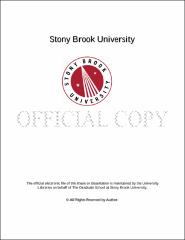| dc.identifier.uri | http://hdl.handle.net/11401/77062 | |
| dc.description.sponsorship | This work is sponsored by the Stony Brook University Graduate School in compliance with the requirements for completion of degree. | en_US |
| dc.format | Monograph | |
| dc.format.medium | Electronic Resource | en_US |
| dc.language.iso | en_US | |
| dc.publisher | The Graduate School, Stony Brook University: Stony Brook, NY. | |
| dc.type | Dissertation | |
| dcterms.abstract | Multidrug resistance is a major obstacle to effective cancer chemotherapy. New-generation taxoids SB-T-1214 and SB-T-1216 have shown two to three orders of magnitude higher potency than those of paclitaxel and docetaxel against multidrug-resistant cancer cell lines. A structure-activity relationship (SAR) study has been conducted in order to test which moiety of the new-generation taxoids account for the high potency against multidrug resistant cancer cell lines. In order to selectively deliver new-generation taxoids into tumor cells, tumor-targeted drug delivery systems with a smart methyl-branched disulfide linker have been developed in the Ojima laboratory. The metabolic stability of this disulfide linker has been assessed in various solvent systems including biologically relevant cell culture media and human blood plasma via real-time kinetic analysis by 19F NMR. Polyamidoamine (PAMAM) dendrimers are attractive anticancer drug delivery vehicles, because of their well-defined architectures and biocompatible properties. Novel PAMAM dendrimer-based tumor-targeting multifunctional conjugates have been designed, synthesized, and characterized. Biological evaluations of these conjugates against various cancer cell lines have been conducted via MTT cytotoxicity assays, confocal fluorescence microscopy (CFM) imaging, and flow cytometry analysis. Potential binding sites of novel benzimidazole inhibitors with FtsZ proteins have been identified via molecular docking, homology modeling, and protein alignment for antitubercular drug discovery. Novel mechanism of action has been proposed based on the docking results. A pharmacophore-guided docking strategy has been developed for designing novel FABP inhibitors as anti-nociceptive and anti-inflammatory agents. Newly designed analogs have better binding energy scores and smaller cLogP values. | |
| dcterms.available | 2017-09-20T16:51:49Z | |
| dcterms.contributor | Rudick, Jonathan G | en_US |
| dcterms.contributor | Ojima, Iwao | en_US |
| dcterms.contributor | Tonge, Peter J | en_US |
| dcterms.contributor | Gupta, Ramesh C. | en_US |
| dcterms.creator | Wei, Longfei | |
| dcterms.dateAccepted | 2017-09-20T16:51:49Z | |
| dcterms.dateSubmitted | 2017-09-20T16:51:49Z | |
| dcterms.description | Department of Chemistry | en_US |
| dcterms.extent | 452 pg. | en_US |
| dcterms.format | Monograph | |
| dcterms.format | Application/PDF | en_US |
| dcterms.identifier | http://hdl.handle.net/11401/77062 | |
| dcterms.issued | 2016-12-01 | |
| dcterms.language | en_US | |
| dcterms.provenance | Made available in DSpace on 2017-09-20T16:51:49Z (GMT). No. of bitstreams: 1
Wei_grad.sunysb_0771E_13039.pdf: 63564939 bytes, checksum: 276c90298ed537a5b84a708ca7d7ca09 (MD5)
Previous issue date: 1 | en |
| dcterms.publisher | The Graduate School, Stony Brook University: Stony Brook, NY. | |
| dcterms.subject | Chemistry | |
| dcterms.subject | FABP, FtsZ, metabolic stability, new-generation taxoids, PAMAM dendrimer, tumor-targeting drug delivery | |
| dcterms.title | Synthetic, Medicinal, and Computational Studies on Novel Anticancer, Antitubercular, and Anti-nociceptive Agents | |
| dcterms.type | Dissertation | |

